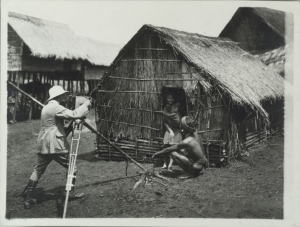Submitted by jp.chazal on Sun, 2010-12-05 00:10
3 - Introduction... 4 - A Western point of view 5 - A difficult topic 6 - Substancing the "savage"?
| 6/6 - Shooting the Montagnards: substancing the "savage"? |
| |
Photography, so the proposition goes, is an encounter. In the case concerned here, it is much more of a collision between a massively "imaging" society and other societies only marginally producers of images as we understand and practise them. It appears there is absolutely no avoiding the issue of the finality of photographs of Montagnards. Like maps and statistics, they did contribute to the definition and placing of the successive versions of colonial domination.
The context is also marked by well-documented colonial reversal of some power relationships prevailing in the home country. The majority of European expatriates shifted from a status of members of the less favoured classes at home, to a place obviously above |
|
We have all been exposed to the image and myth of savages cooking the white explorer in a huge cauldron in preparation for a feast. Real or fanciful, the situation represented was immediately interpreted by native populations as ritual abduction of their own spirit (the technical conditions that prevailed down to the second quarter of the 20th century imposed long minutes of artificial positioning - and the operator did not as a rule reward them with a copy of the final product). As matters stand now, our images of them may well be seen as both a stage, and a major tool, in a process of ingestion-digestion-assimilation, even though Western societies protest that great care was taken not to represent the local populations as commodities for civilised consumption. |
|
 Young man squatting before a woman and baby in the opening
Young man squatting before a woman and baby in the opening
of a house filmed by a white man. René Têtard, around 1919
|
| |
native condition; they made the shift manifest by adopting the very attitudes of the dominant classes they had been subjected to at home. Big or small game hunting inevitably flourishing in jungle environments soon doubles up as image-hunting, image as trophy, safaris gone photographic. Exotic as it is, the photographic "bag" admits of themes and situations in slavish conformity with those of popular photography making great strides at home at the time. Same and other court each other.
The savage cannibalised in images
|
|
Photography as representation has been defined as index or trace (in the way a smoke is index of a fire): we are concerned here with smoke as aroma of delectable consummation.
These documents are like Discourses of the Dead challenged by the Montagnards' own ritual ceremony waving goodbye to the tomb. We do hope that offsprings of the Montagnards on the photos may invite us to attend such a process of appropriation in reverse - reminding us all the time not to err in interpreting the remains 1 in the dangerous light of an age of invading nostalgia. |
|
|
1
- "Maybe we have to ask whether the relative lack of imagination shown in these sorts of photographs in fact shifts the burden of imaginative thought from the artist and subject, where historians usually seek it, to the viewer, who is invited by such pictures to see much more than meets the eye. Certainly, when I examine a snapshot of a loved one, I see how they once looked, but I also project how I feel about that person onto the picture. The snapshot conjures how they were then and how I am now, in the same all-encompassing look.
Batchen, Geoffrey(2008) 'SNAPSHOTS', Photographies, 1: 2, 121 — 142.
|
|
Jean-Pierre Chazal - All rights reserved 2010
|

